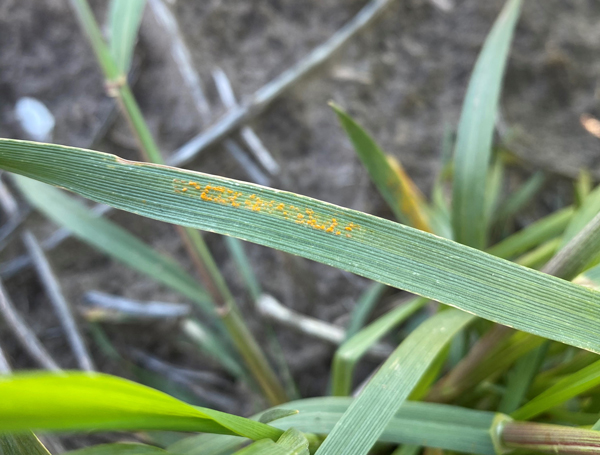Rainy, cool weather late in the season has led to trace levels of stripe rust showing up in many counties in central and western Kansas (Figure 1). In most locations, disease levels are well below action levels for a fungicide application, and there is very little concern about yield losses. Additionally, with much of the state moving into or past grain fill stages of development, it is largely too late to apply fungicides. As a reminder, all fungicides labeled for wheat have pre-harvest restrictions ranging from 30-35 days prior to harvest or that are growth stage specific. Most products with growth stage specific restrictions either cannot be applied past full head emergence (Feekes 10.5) or the watery ripe growth stage (Feekes 10.5.1). We have conveniently included these restrictions in the K-State Wheat Fungicide Publication (https://bookstore.ksre.ksu.edu/pubs/ep130.pdf). More information on growth staging wheat can be found here: https://bookstore.ksre.ksu.edu/pubs/MF3300.pdf. Always consult the label prior to application of any pesticide.

Figure 1. Distribution of stripe rust in Kansas as of April 29, 2021. The map is based on observations of K-State Research and Extension, crop consultants, and wheat producers in the state. Map created by Kelsey Andersen Onofre, K-State Research and Extension.
Stripe rust is most yield-limiting when it builds early in the season and advances to the upper canopy, particularly the flag leaf. The risk of stripe rust causing yield loss is a function of three things:
- Timing of first local disease detection in relation to crop growth stage (earlier detection = higher risk)
- Weather conditions: specifically, temperature and moisture after the first detection
- Variety genetics: varieties with better resistance ratings will generally benefit less from a fungicide application. Variety ratings can be found in the K-State Wheat Variety Disease and Insect Rating Guide: https://bookstore.ksre.ksu.edu/pubs/MF991.pdf
Deciding on a fungicide application to control stripe rust
Most fields in Kansas are past the pre-harvest intervals for a fungicide application and no application should be considered at this point. The exception may be the state’s northwest corner where some late-maturing wheat is still in the flowering or early kernel-filling stages of development.
The decision to apply a fungicide should be balanced with the yield potential of the crop and the current grain price. Fields potentially yielding greater than 40 bushels per acre or seed production fields should be prioritized for a fungicide application.
Scouting is a critical first step for stripe rust control. Stripe rust can be identified by characteristic orange lesions forming straight lines on mature plants (Figure 2). When you run your finger over a stripe rust pustule, the orange spores will be easily dislodged.

Figure 2. Classic symptoms of stripe rust. Photo by Kelsey Andersen Onofre, K-State Research and Extension.
Fungicide applications are most beneficial when the level of disease in the field is below 10% severity. University research has demonstrated that applications that protect the fully emerged flag leaf (between Feekes 8 and Feekes 10) are most effective, although late applications at flowering can provide stripe rust protection when disease onset is late (such as this year). See this K-State publication for additional information about growth staging wheat: https://bookstore.ksre.ksu.edu/pubs/MF3300.pdf. Applications applied prior to flag leaf emergence will not adequately protect the flag leaf or the head. Always check and follow product label recommendations to ensure full compliance with growth-stage limitations and pre-harvest intervals.
There are many products that are rated very good or excellent for stripe rust control (http://www.bookstore.ksre.ksu.edu/pubs/EP130.pdf).
The products listed in the K-State fungicide efficacy publication will generally provide at least 14-21 days of protection. This can vary between products and is also influenced by environmental conditions.
Kelsey Andersen Onofre, Extension Wheat Pathologist
andersenk@ksu.edu
Tags: disease wheat fungicide stripe rust